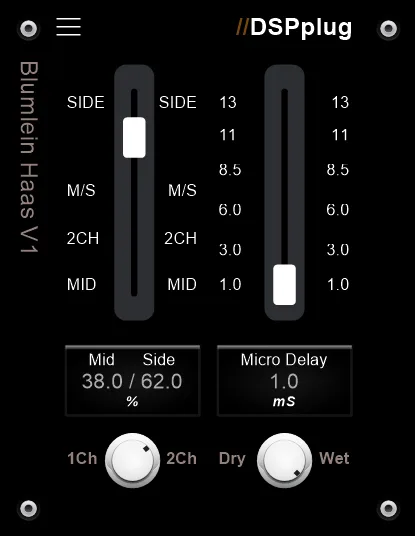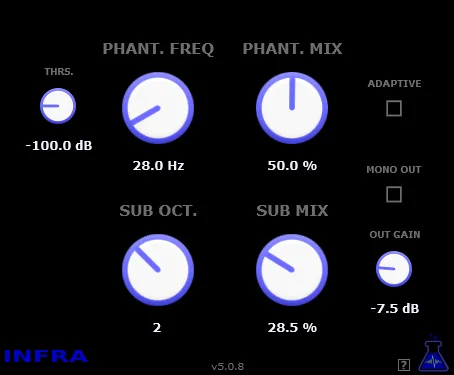Master of Your Stereo Space: A Review of the Blumlein Haas Plugin
In the world of music production and sound design, the stereo image plays an incredibly important role. It’s what creates a sense of space, depth, and panorama, immersing the listener in a unique sound atmosphere. Controlling the width, depth, and focus of the stereo signal is a key element in creating professionally mixed tracks that sound voluminous and balanced on any sound system.
This is where specialized stereo tools, such as the Blumlein Haas plugin from the developer DSPplug, come to the rescue. This plugin is a powerful Mid-Side (M/S) processor that uses principles that revolutionized the field of stereophony in their time.
What’s Behind the Name? History and Principles
The name Blumlein Haas is no accident; it refers us to two pioneers of sound recording and psychoacoustics whose ideas formed the basis of modern stereophony:
Alan Blumlein
British engineer Alan Blumlein is considered one of the fathers of modern stereophony. Back in the 1930s, he patented numerous inventions in this field, including the so-called “Blumlein Pair” – a stereo recording technique using two bidirectional (figure-8) microphones positioned at a 90-degree angle. This technique actually became one of the early manifestations of the Mid-Side principle, where the “Mid” signal is formed by the sum of the signals from both microphones, and the “Side” signal is their difference. Blumlein’s work demonstrated how spatial information could be encoded in two channels.
Haas Effect
The name of the effect comes from the German scientist Helmut Haas, who in 1949 studied how the human ear perceives sound coming from different directions and with a slight delay. The Haas effect (or precedence effect) states that if identical sound reaches the listener from two different sources with a delay of 1 to 50 milliseconds, a person will perceive it as one sound localized closer to the first source. The second source is not perceived as a separate echo, but adds a sense of space, “volume,” and width. It is this psychoacoustic phenomenon that is actively used in many stereo effects, including those that simulate early reflections or create a sense of presence.
The Blumlein Haas plugin combines these fundamental concepts, offering a unique approach to stereo signal processing, using M/S principles and the Haas effect to shape the spatial image.
How does Blumlein Haas work?
The plugin is based on Mid-Side processing. The input stereo signal (or even mono) is decomposed into two components:
- Mid (Middle): The sum of the left and right channels (L+R). This is the central, mono-compatible part of the signal.
- Side (Sides): The difference between the left and right channels (L-R). This is information about the difference between the channels, which is responsible for the feeling of the width of the stereo field.
Blumlein Haas applies the principles of the Haas effect to these components (or to the signal processed according to Blumlein’s principles), allowing you to manipulate how the listener perceives the spatial location and width of the sound. The plugin works with both mono and stereo files. When processing a mono file, it can “expand” it, creating artificial stereo based on the principles of the Haas effect and M/S. When working with a stereo file, it allows you to control the existing width, making the sound more focused in the center or, conversely, as wide as possible.
The revolutionary aspect of this approach lies in the ability to finely tune the stereo space, affecting precisely those components of the signal that are responsible for width and spatial perception, using psychoacoustic effects.
Advantages of using Blumlein Haas
Using this plugin in your workflow can have significant advantages:
- Expanding mono sources: Converting monophonic instruments (e.g., vocals, guitar) into a wider, “airy” stereo, adding space and presence to the mix.
- Controlling stereo width: The ability to make a stereo track (e.g., keyboards, pads, backing vocals, guitars) wider for better filling of the stereo field or, conversely, narrow it to make room for other elements of the mix.
- Improving the stereo image: Correcting problems with stereo phase or unwanted narrowness/width of existing recordings.
- Creative sound design: Creating interesting spatial effects and textures that go beyond standard panning.
- Increasing mono compatibility: Although the plugin expands stereo, M/S processing often helps to better control how the sound will behave when played in mono, allowing you to check and minimize phase problems.
Blumlein Haas is not just a standard equalizer or compressor that works in M/S mode. It is a tool designed specifically for manipulating spatial perception, using time-tested principles of sound recording and psychoacoustics.
Technical aspects
The Blumlein Haas plugin is available in VST format for Windows operating systems (both 32-bit and 64-bit versions).
Conclusion
If you are looking to gain full control over the stereo space of your mixes, add volume to mono sources, or creatively experiment with sound imaging, Blumlein Haas from DSPplug is a tool that deserves your attention. It offers a unique combination of historical innovation and modern processing capabilities, allowing you to shape the sound the way you hear it.
Try Blumlein Haas and discover new horizons in stereo work!



